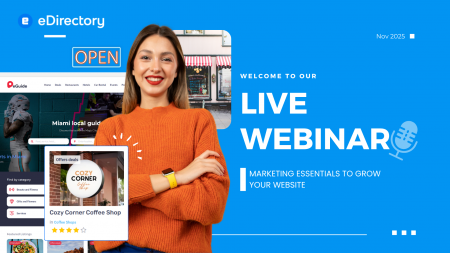
Creating an online directory has become easier than ever, but seeing it thrive requires much more than simply launching a website. Whether you’re building a directory, membership platform, or any online business, the ultimate goal is financial success — and strategy is what determines how far your project will go.
In this webinar, we explored the key marketing principles and practical methods you can apply to grow your website with confidence. Here’s a complete article-style breakdown of everything covered. Let’s dive in.
1. Decide Your Short and Long-Term Goals
A strong marketing strategy always starts with clarity. Knowing exactly what you want sets the tone for every decision you make.
Why Clear Goals Matter
Focused goals help you:
-
Direct your time and resources efficiently
-
Measure progress
-
Stay accountable
-
Make better decisions
Typical goals for directory-style websites include increasing traffic, boosting user registrations, and growing paid memberships.
Creating Actionable Goals
A goal without steps is just a wish. Break large objectives into smaller actions.
If your goal is to grow traffic by 20%, you might:
-
Optimize content for SEO
-
Run targeted advertising
-
Publish content consistently on social media
Choose a Realistic Timeframe
Deadlines help you track progress:
-
Short-term (1–3 months): Launching a campaign, updating listings, publishing new content
-
Long-term (6–12 months): Reaching a revenue milestone, doubling memberships
Ask yourself: What do I want to accomplish this month? This quarter? This year?
2. Conduct Market Research
No marketing strategy succeeds without understanding the landscape you’re competing in.
Why Market Research Is Crucial
It helps you:
-
Understand your niche
-
Identify trends and opportunities
-
Evaluate competitors
-
Learn what users actually want
How to Do Market Research
Start by analyzing your competitors:
-
What features do they offer?
-
What pricing model do they use?
-
How strong is their design and user experience?
Next, gather insights from your audience:
-
Run surveys or polls
-
Engage with them on social media
-
Read reviews or feedback
-
Identify their pain points
Use Data to Guide Your Decisions
Tools like Google Analytics, keyword research platforms, and social listening tools show you:
-
What your audience is searching for
-
Which categories are in high demand
-
What gaps you can fill
This step ensures your marketing strategy is driven by real needs — not assumptions.
3. Build a Strong Marketing Strategy
Once you understand your goals and market, you can shape a strategy designed for growth.
Branding and Positioning
Define your Unique Value Proposition (UVP):
-
What makes your directory different?
-
Why should users choose you over a competitor?
Consistent design, messaging, and tone build familiarity and trust.
Know Your Audience
Create detailed personas to understand:
-
Demographics
-
Goals
-
Problems they want to solve
Then segment your audience for more personalized campaigns.
Choose the Right Channels
Your directory doesn’t need to be everywhere — just where your audience is.
Examples:
-
LinkedIn: Professional and B2B directories
-
Instagram/Facebook: Lifestyle, local, or community directories
-
TikTok: Younger, trend-driven markets
Balance organic efforts (SEO, blogs, social media) with paid strategies (Google Ads, social ads, retargeting).
Don’t forget partnerships, collaborations, and community-building activities.
4. Test, Analyze, Adjust, Repeat
Marketing is never “set and forget.” Continuous optimization is key.
Tools for Measurement
Track your performance using:
-
Google Analytics
-
Hotjar or heatmap tools
-
A/B testing platforms
Monitor metrics like:
-
Traffic
-
Bounce rate
-
Conversions
-
Time on page
Adjust Your Strategy Based on Data
If something isn’t working:
-
Refine your targeting
-
Update messaging
-
Improve landing pages
-
Adjust your content strategy
Successful websites evolve — they don’t rely on the first version of anything.
5. Market Your Directory Website
With your strategy in place, it’s time to promote your platform effectively.
Growth Tactics
-
Content Marketing: Publish helpful blog posts, guides, or category spotlights
-
Email Marketing: Build a subscriber list and send consistent value
-
Community Engagement: Interact on forums, groups, and social channels
-
Partnerships: Collaborate with complementary businesses
Paid Advertising
Use targeted ads to attract the right audience and retarget users who didn’t convert.
Experiment with:
-
Google search ads
-
Social ads
-
Display campaigns
Track performance and optimize for conversions.
SEO Optimization
SEO is essential for long-term growth. Focus on:
-
Optimizing listings and categories
-
Filling out meta titles, descriptions, and URLs
-
Using keywords naturally
-
Getting backlinks
-
Optimizing for local SEO if your directory is regional
Every listing and category can become an entry point for new visitors.
6. Conclusion
Key Takeaways
-
Clear goals shape your strategy
-
Market research reveals opportunities
-
A strong brand and targeted messaging drive results
-
Continuous testing keeps your growth consistent
-
SEO, content, email, and paid ads all play key roles
Your Next Steps
Start small.
Choose one strategy to implement this week.
Track results, learn from them, and improve.
Growth is a process — and every step counts.
WEBINAR: MARKETING ESSENTIALS TO GROW YOUR WEBSITE
This session was recorded in November 2025.
USEFUL LINKS AND TOOLS MENTIONED IN THE WEBINAR
- Webinar Deck (.pdf)
- Don’t forget to register for eDirectory’s next Webinar.
- Join our closed Facebook Group for tips and news
Want more tips? Shoot us a note at marketing@eDirectory.com.


